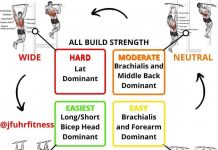How to Perform Pull Ups
Pull-ups are an extremely effective exercise for growing upper body muscles and maintaining a healthy posture. This is one of the favorite exercises for many men. Usually, they pay attention to the classic version, but in fact, there are a lot of them, and each has a different effect on muscle development. Pull-ups have their own technical characteristics that must be considered in order to get the most out of your workout.
If you do not have physical activity, this can lead to the fact that the muscles become small and weak. We gain excess weight, and the load falls on the joints, ligaments, bones, and vertebrae. The result of this is back pain, crooked posture, osteochondrosis, pinched blood vessels, and an unattractive figure. With pull-ups, you can improve your overall fitness level and eliminate these unpleasant factors.
What works during pull-ups?
- Wide muscle: lower back, trapezius, rhomboid, round;
- Muscles of the chest: pectoralis major and minor, serratus anterior;
- Arm muscles: biceps, triceps, delts, forearms;
- Core muscles.
These exercises will help you build an aesthetic body. If you can’t go to the gym, do it on street sports grounds.
1. Jumping pull-ups
- Pros: Very easy way.
- Cons: Not suitable for heavy people, requires good coordination.
- Approach the horizontal bar.
- Jump up, creating the momentum of the flight.
- In flight, grab the horizontal bar with your hands and pull yourself up, helping inertia with muscle strength.
- Slowly return to starting position
Perform at least 3 sets of 2-3 or more repetitions, with a break of several minutes. 2-3 times a week.
2. Static pull-up
- Pros: A very affordable method, you only need a horizontal bar. For beginners.
- Cons: Not a self-sufficient method. Suitable as an auxiliary method for beginners. You will need to reinforce other types of pull-up training.
- Go to a horizontal bar that is not much higher than your head
- Grap on the high bar and pull yourself up to the level of the chin
- Try to hang as long as possible, resisting gravity.
After hanging for the maximum time, take a break for a few minutes and do the next set. At least 3 sets, 2-3 times a week.
3. Partial Pull-ups
- Pros: The most efficient way.
- Cons: You need to be able to pull yourself up at least a couple of inches.
- Approach the horizontal bar.
- Hold on to the high bar, arms straight.
- Pull up as high as you can.
- Straighten your arms.
After doing a few partial reps, take a 2-3 minute break and do the next set. At least 3 sets, 2-3 times a week.
There is a version of the technique where you pull yourself up to the chin, but go down 10 cm. Use both versions for training!
4. Negative Pull-ups
- Pros: No partner required
- Cons: This pull-up method is not for everyone
- Approach the horizontal bar
- Climb up with a jump, or use a stand
- Hang from the bar so that your chin is above the bar
- Slowly lower yourself until your arms are straightened, lower yourself very slowly without making sudden movements.
Your work is a slow downward movement. We skip the positive phase, rise quickly up, and slowly descend.
3-6 reps, then rest 3 minutes and the next set. 3-5 sets, 1-2 times a week.
5. Snatch pull-ups
- Pros: No partner or weights required
- Cons: Needs good coordination and classic pull-up skills
- Hang on the high bar, legs straight
- Sharply bend your knees, pushing your body upward.
Strain the muscles of the arms and the whole body and with the help of a jerk lift yourself to the crossbar until your chin is at the level of the crossbar
3-5 sets with a break of 2-3 minutes. 2-3 times a week.
6. Gravitron Pull-ups
- Pros: Efficient, good for beginners
- Cons: requires the presence of a simulator “gravitron”
- Approach the simulator gravitron
- Adjust the support force so that the weight of the counterweight plates is less than your weight.
- Stand on a special platform, grab the horizontal bar with your hands
- Start pulling up with the help of the simulator
Perform at least 3 sets with a break of a few minutes. Do it 2-3 times a week.
7. Pull-ups with a spotter
- Pros: Pretty efficient.
- Cons: Requires an experienced and strong spotter
- Come to the high bar, grasp the horizontal bar with your hands, then bend your knees and strain them.
- A partner grabs your legs around the lower leg and helps you so that you do the reps, but with maximum difficulty.
Perform at least 3 sets with a break of a few minutes. Do it 2-3 times a week.
Alternatives to pull-ups
Instead of doing pull-ups, you can do seated pulldowns. If you gradually increase the weight, then sooner or later you will start to pull yourself up.






















































